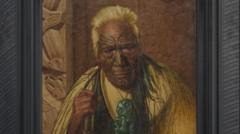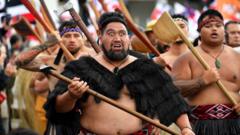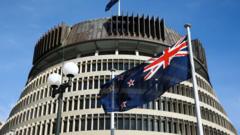An iconic painting by Charles Frederick Goldie sells for NZ$3.75 million, marking a pivotal moment in Māori representation and an emblem of the ongoing socio-political struggles faced by the Māori community.
Record-Breaking Māori Artwork Auctioned Amidst Tensions

Record-Breaking Māori Artwork Auctioned Amidst Tensions
Historic sale reflects cultural significance and societal challenges in New Zealand.
Despite ongoing racial tensions in New Zealand, an oil painting of a Māori elder, titled "Thoughts of a Tohunga," has sold for a staggering NZ$3.75 million ($2.2 million) at the International Art Centre auction. This price not only sets a record for the highest artwork sold at auction in New Zealand but also establishes it as the most valuable Māori portrait in the nation's artistic history. The piece, created in 1938 by renowned artist Charles Frederick Goldie, features the likeness of Wharekauri Tahuna, a priest who is reportedly one of the last tattooed figures of his lineage.
Lately, New Zealand has witnessed heightened racial tensions, exacerbated by a recent government bill that Māori leaders allege threatens their rights. Goldie's "Thoughts of a Tohunga," completed just nine years before his death in 1947, is hailed by critics as one of his finest works. It captures Tahuna adorned with a traditional moko (facial tattoo) and a hei-tiki pendant, encapsulating an integral part of Māori culture.
The artwork was sold to an undisclosed buyer following its first appearance at auction in over three decades. Richard Thomson, director at the International Art Centre, emphasized Goldie's deep connections with Māori people during his lifetime and how he frequently portrayed subjects directly from their communities. Thomson shared that since 2016, his auction house has facilitated the sale of 13 Goldie paintings, each fetching over a million dollars.
While Māori represent approximately 18% of New Zealand's population, socio-economic disparities persist. Current challenges include significant gaps in health outcomes, educational attainment, and life expectancy, with Māori living, on average, seven years less than their non-Māori counterparts. Recently, a political party attempted to push a bill to reinterpret the historic Treaty of Waitangi with Māori populations, but public backlash led to a nine-day protest march against the legislation, which ultimately did not pass. This context makes the record-breaking art sale not merely an economic event but a pivotal discussion point in the ongoing dialogue surrounding Māori rights and representation in New Zealand society.
Lately, New Zealand has witnessed heightened racial tensions, exacerbated by a recent government bill that Māori leaders allege threatens their rights. Goldie's "Thoughts of a Tohunga," completed just nine years before his death in 1947, is hailed by critics as one of his finest works. It captures Tahuna adorned with a traditional moko (facial tattoo) and a hei-tiki pendant, encapsulating an integral part of Māori culture.
The artwork was sold to an undisclosed buyer following its first appearance at auction in over three decades. Richard Thomson, director at the International Art Centre, emphasized Goldie's deep connections with Māori people during his lifetime and how he frequently portrayed subjects directly from their communities. Thomson shared that since 2016, his auction house has facilitated the sale of 13 Goldie paintings, each fetching over a million dollars.
While Māori represent approximately 18% of New Zealand's population, socio-economic disparities persist. Current challenges include significant gaps in health outcomes, educational attainment, and life expectancy, with Māori living, on average, seven years less than their non-Māori counterparts. Recently, a political party attempted to push a bill to reinterpret the historic Treaty of Waitangi with Māori populations, but public backlash led to a nine-day protest march against the legislation, which ultimately did not pass. This context makes the record-breaking art sale not merely an economic event but a pivotal discussion point in the ongoing dialogue surrounding Māori rights and representation in New Zealand society.



















